Factors Affecting Employees’ Problem-Solving Skills in Technology-Rich Environments in Japan and Korea
Abstract
1. Introduction
1.1. Cultural Capital
1.2. Participation in Training
1.3. Skill Usage
1.4. Age
1.5. Research Questions
2. Data Sources and Methods
3. Results
4. Discussion
5. Conclusions
Author Contributions
Funding
Conflicts of Interest
References
- Desjardins, R.; Ederer, P. Socio-demographic and practice-oriented factors related to proficiency in problem solving: A lifelong learning perspective. Int. J. Lifelong Educ. 2015, 34, 468–486. [Google Scholar] [CrossRef]
- Bonekamp, L.; Sure, M. Consequences of Industry 4.0 on human labour and work organisation. J. Bus. Media Psychol. 2015, 6, 33–40. [Google Scholar]
- Autor, D.H.; Price, B. The Changing Task Composition of the US Labor Market: An Update of Autor, Levy, and Murnane (2003). MIT Working Paper. 2013. Available online: https://economics.mit.edu/files/9758 (accessed on 27 August 2020).
- CEDEFOP. Forecasting Skill Demand and Supply: Employment trend. 2016. Available online: http://www.cedefop.europa.eu/de/events-and-projects/projects/forecasting (accessed on 27 August 2020).
- OECD. Literacy, Numeracy and Problem Solving in Technology-Rich Environments; OECD: Paris, France, 2012. [Google Scholar]
- World Economic Forum. The Future of Jobs: Employment, Skills and Workforce Strategy for the Fourth Industrial Revolution; World Economic Forum: Geneva, Switzerland, 2016. [Google Scholar]
- Hämäläinen, R.; De Wever, B.; Nissinen, K.; Cincinnato, S. What makes the difference–PIAAC as a resource for understanding the problem-solving skills of Europe’s higher-education adults. Comput. Educ. 2019, 129, 27–36. [Google Scholar] [CrossRef]
- Strakova, J.; Vesely, A. Other Things Being Equal: Comparing Literacies in the Czech and Slovak Republics. Comp. Educ. Rev. 2019, 63, 418–438. [Google Scholar] [CrossRef]
- Zahavi, M.; BenDavid-Hadar, I.; Klein, J. Education and competencies within Belt and Road countries. Int. J. Educ. Manag. 2019, 33, 1411–1430. [Google Scholar] [CrossRef]
- Guillory, J. Cultural Capital: The Problem of Literary Canon Formation; University of Chicago Press: Chicago, IL, USA, 2013. [Google Scholar]
- Desjardins, R.; Rubenson, K. Participation Patterns in Adult Education: The role of institutions and public policy frameworks in resolving coordination problems. Eur. J. Educ. 2013, 48, 262–280. [Google Scholar] [CrossRef]
- Organisation for Economic Co-operation and Development. OECD Skills Outlook 2013: First Results from the Survey of Adult Skills; OECD: Paris, France, 2013. [Google Scholar] [CrossRef]
- Cummins, P.A.; Yamashita, T.; Millar, R.J.; Sahoo, S. Problem-Solving Skills of the U.S. Workforce and Preparedness for Job Automation. Adult Learn. 2019, 30, 111–120. [Google Scholar] [CrossRef]
- Støren, L.A.; Lundetræ, K.; Børing, P. Country differences in numeracy skills: How do they vary by job characteristics and education levels? Int. J. Lifelong Educ. 2018, 37, 578–597. [Google Scholar] [CrossRef]
- Boussanlègue, T.; Biriziwè, H.; Esso-Mondjonna, M.; Essè, A. Performances of Elementary Pupils in French and Mathematics and Socio-Professional Category and the Formal Education Level of Parents in Togo. Int. J. Educ. Rev. 2020, 3, 53–62. [Google Scholar] [CrossRef]
- Hultqvist, E.; Lidegran, I. The use of ‘cultural capital’ in sociology of education in Sweden. Int. Stud. Sociol. Educ. 2020, 1–8. [Google Scholar] [CrossRef]
- Gustafsson, J.-E. Lasting effects of quality of schooling: Evidence from PISA and PIAAC. Intelligence 2016, 57, 66–72. [Google Scholar] [CrossRef]
- Fuchs, T.; Wößmann, L. What accounts for international differences in student performance? A re-examination using PISA data. Empir. Econ. 2006, 32, 433–464. [Google Scholar] [CrossRef]
- Lee, J.H.; Choi, S. Skills of Koreans: Empirical Analysis and Future Strategies. Kdi Res. Monogr. 2015, 8, 1–382. [Google Scholar]
- CEDEFOP On the Way to 2020: Data for Vocational Education and Training Policies Indicator Overviews: 2019 Update; CEDEFOP Reseach Paper; CEDEFOP: Thessaloniki, Greece, 2019. [CrossRef]
- Bozkurt, A.; Ucar, H. Blockchain Technology as a Bridging Infrastructure Among Formal, Non-Formal, and Informal Learning Processes. In Cross-Cultural Considerations in the Education of Young Immigrant Learners; IGI Global: Hershey, PA, USA, 2020; pp. 1–15. [Google Scholar]
- Wallet, P. The UNESCO Institute for Statistics (UIS) Strategy on Teacher Statistics: Developing Effective Measures of Quantity and Quality in Education. Int. Perspect. Educ. Soc. 2015, 27, 39–85. [Google Scholar]
- Choi, S.J.; Kim, S.N. A Comparative Study on the Influence of the Non-formal Lifelong Learning Participation and Usage of Skills to the Adult’s Key Competencies: Using Propensity Score Matching Method. J. Vocat. Educ. 2015, 34, 93–120. [Google Scholar]
- Choi, Y.J. An Analysis of the Effects of Adult Learning Participation on Competencies in OECD PIAAC: Using Propensity Score Matching. J. Lifelong Educ. 2015, 21, 139–167. [Google Scholar]
- Hamm, J.M.; Heckhausen, J.; Shane, J.; Lachman, M.E. Risk of cognitive declines with retirement: Who declines and why? Psychol. Aging 2020, 35, 449–457. [Google Scholar] [CrossRef]
- Levels, M.; van der Velden, R. Use it or lose it? Explaining age-related differences in key information processing skills. In Proceedings of the PIAAC Invitational Research Conference: The Importance of Skills and How to Assess Them, Washington, DC, USA, 13–15 November 2013; Available online: http://www.nvdemografie.nl/sites/default/files/rolf_van_der_velden_-_keynote_use_it_or_lose_it.pdf (accessed on 27 August 2020).
- Chang, Y.-H.; Wu, I.-C.; Hsiung, C.A. Reading activity prevents long-term decline in cognitive function in older people: Evidence from a 14-year longitudinal study. Int. Psychogeriatr. 2020, 1–12. [Google Scholar] [CrossRef]
- Felstead, A.; Gallie, D.; Green, F.; Henseke, G. The determinants of skills use and work pressure: A longitudinal analysis. Econ. Ind. Democr. 2016, 40, 730–754. [Google Scholar] [CrossRef]
- OECD. The Survey of Adult Skills; Organisation for Economic Co-Operation and Development (OECD): Paris, France, 2016. [Google Scholar]
- Seo, Y.J.; Kwon, Y.K. Korean Competence, Learning and Work; Korea Development Institute: Sejong, Korea, 2013. [Google Scholar]
- Patterson, M.B. The Forgotten 90%: Adult Nonparticipation in Education. Adult Educ. Q. 2017, 68, 41–62. [Google Scholar] [CrossRef]
- Ganzach, Y.; Patel, P.C. Wages, mental abilities and assessments in large scale international surveys: Still not much more than g. Intelligence 2018, 69, 1–7. [Google Scholar] [CrossRef]
- Lindberg, M.; Silvennoinen, H. Assessing the basic skills of the highly educated in 21 OECD countries: An international benchmark study of graduates’ proficiency in literacy and numeracy using the PIAAC 2012 data. Comp. Educ. 2017, 54, 325–351. [Google Scholar] [CrossRef]
- Tikkanen, T.; Nissinen, K. Drivers of job-related learning among low-educated employees in the Nordic countries. Int. J. Lifelong Educ. 2018, 37, 615–632. [Google Scholar] [CrossRef]
- Yalcin, S. Competence Differences in Literacy, Numeracy, and Problem Solving According to Sex. Adult Educ. Q. 2019, 69, 101–119. [Google Scholar] [CrossRef]
- Barrett, G.F.; Riddell, W.C. Ageing and Literacy Skills: Evidence from IALS, ALL and PIAAC; IZA Discussion Papers No. 10017; Institute for the Study of Labor (IZA): Bonn, Germany, 2016. [Google Scholar]
- Allen, J.; van der Velden, R. Skills for the 21st century: Implications for dutch education. In Higher Education: Recent Trends, Emerging Issues and Future Outlook; Nova Science Publishers, Incorporated: Hauppauge, NY, USA, 2013; pp. 1–40. [Google Scholar]
- Fernández-De-Álava, M.; Quesada-Pallarès, C.; Carmona, M.G. Use of ICTs at work: An intergenerational analysis in Spain / Uso de las TIC en el puesto de trabajo: Un análisis intergeneracional en España. Cult. Y Educ. 2017, 29, 1–31. [Google Scholar] [CrossRef]
- Tong, T.; Li, H.; Greiff, S. Human capital and leadership: The impact of cognitive and noncognitive abilities. Appl. Econ. 2019, 51, 5741–5752. [Google Scholar] [CrossRef]
- Hämäläinen, R.; De Wever, B.; Malin, A.; Cincinnato, S. Education and working life: VET adults’ problem-solving skills in technology-rich environments. Comput. Educ. 2015, 88, 38–47. [Google Scholar] [CrossRef]
- Cabrillana, A.H.; Kuehn, Z.; Lopez-Mayan, C. Development accounting using PIAAC data. SERIEs 2017, 8, 373–399. [Google Scholar] [CrossRef]
- Tikkanen, T. Problem-solving skills, skills needs and participation in lifelong learning in technology-intensive work in the Nordic countries. Sodob. Pedagog. J. Contemp. Educ. Stud. 2017, 68, 110–128. [Google Scholar]
- OECD. International Institute for Applied Systems Analysis Systemic Thinking for Policy Making. Systemic Thinking for Policy Making 2020; OECD: Paris, France, 2020. [Google Scholar]
- Baral, R.; Bhargava, S. Work-family enrichment as a mediator between organizational interventions for work-life balance and job outcomes. J. Manag. Psychol. 2010, 25, 274–300. [Google Scholar] [CrossRef]
- Daniel, S.; Sonnentag, S. Work to non-work enrichment: The mediating roles of positive affect and positive work reflection. Work. Stress 2014, 28, 49–66. [Google Scholar] [CrossRef]
- Lee, E.-S.; Chang, J.Y.; Kim, H. The work–family interface in Korea: Can family life enrich work life? Int. J. Hum. Resour. Manag. 2011, 22, 2032–2053. [Google Scholar] [CrossRef]


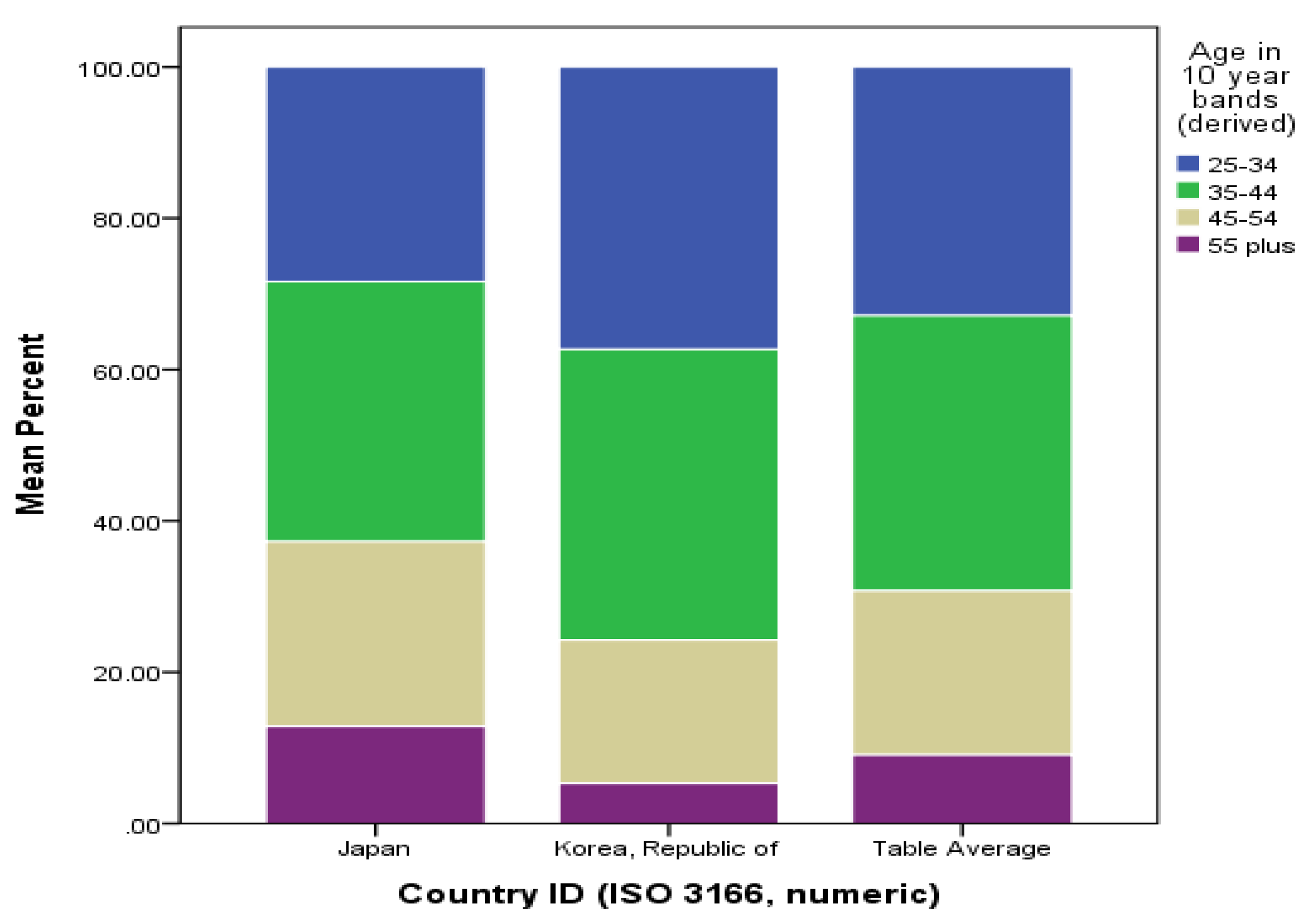
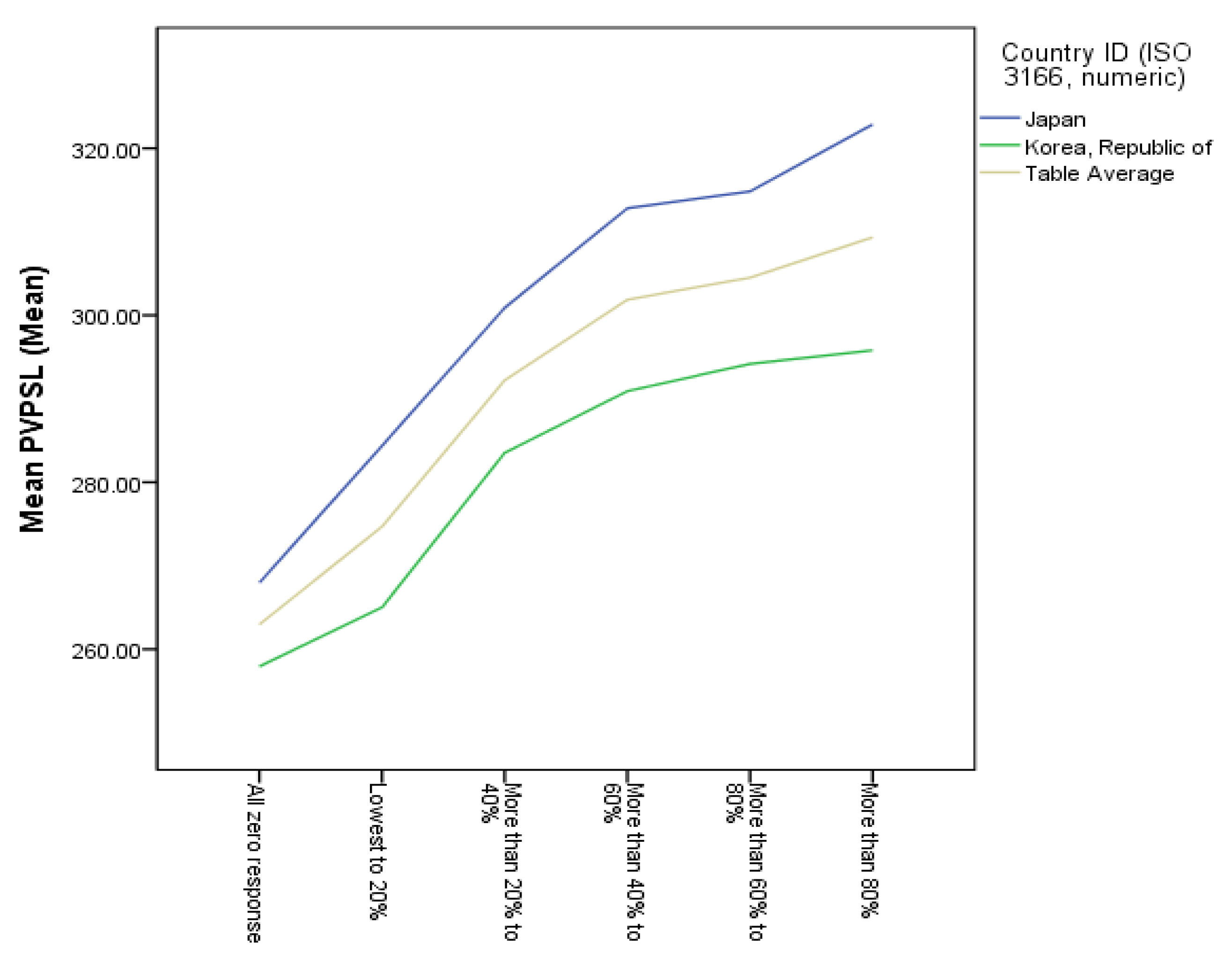
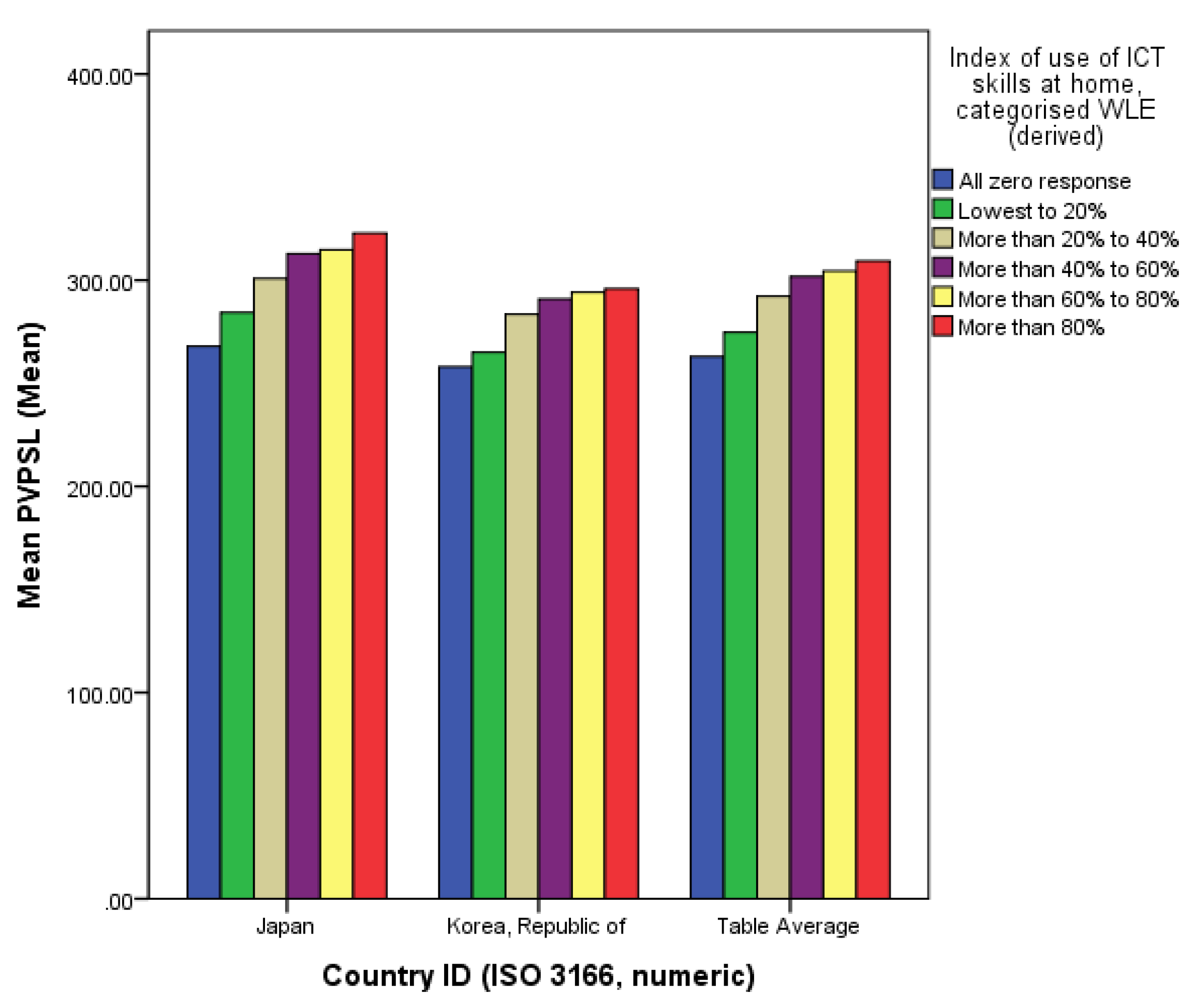
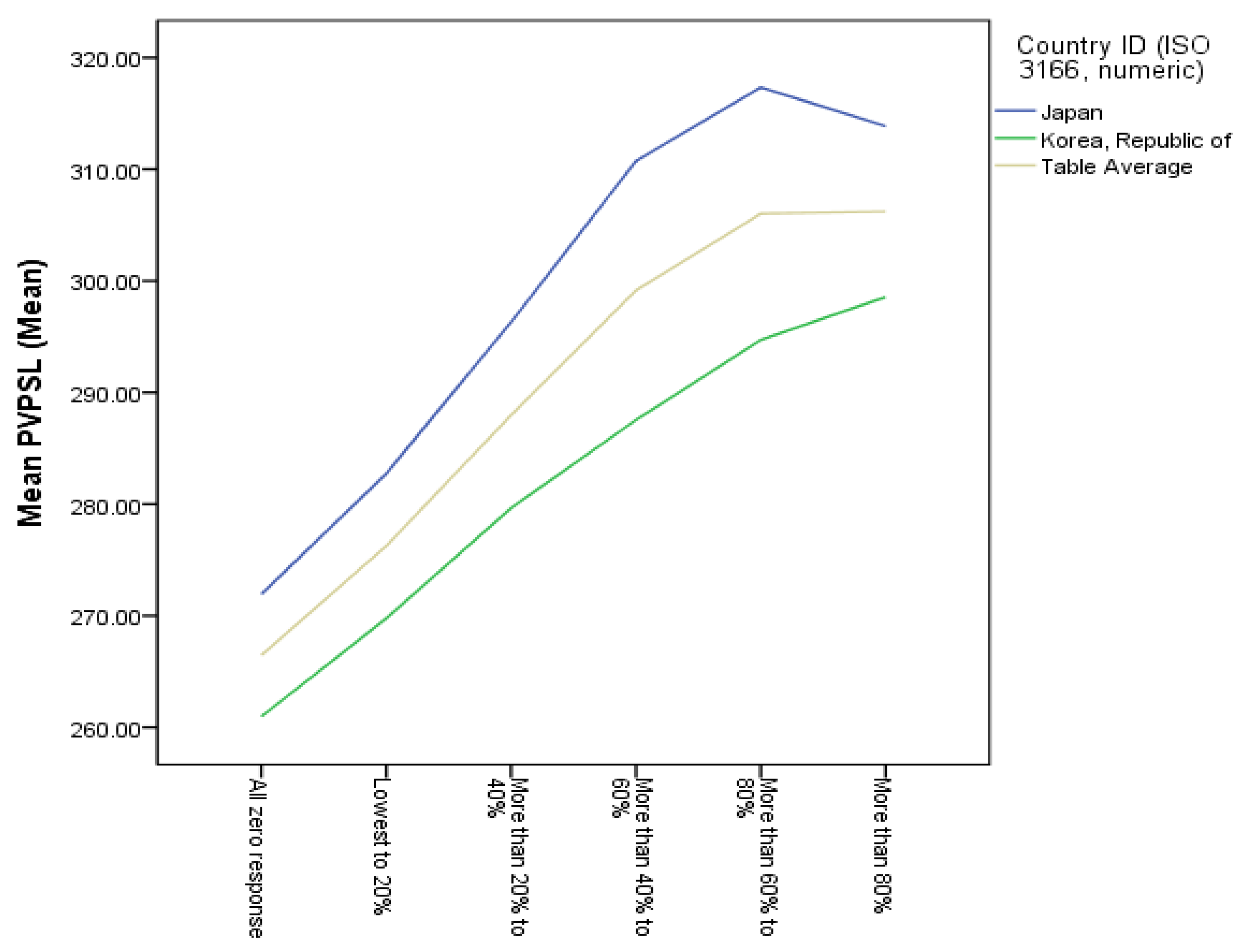
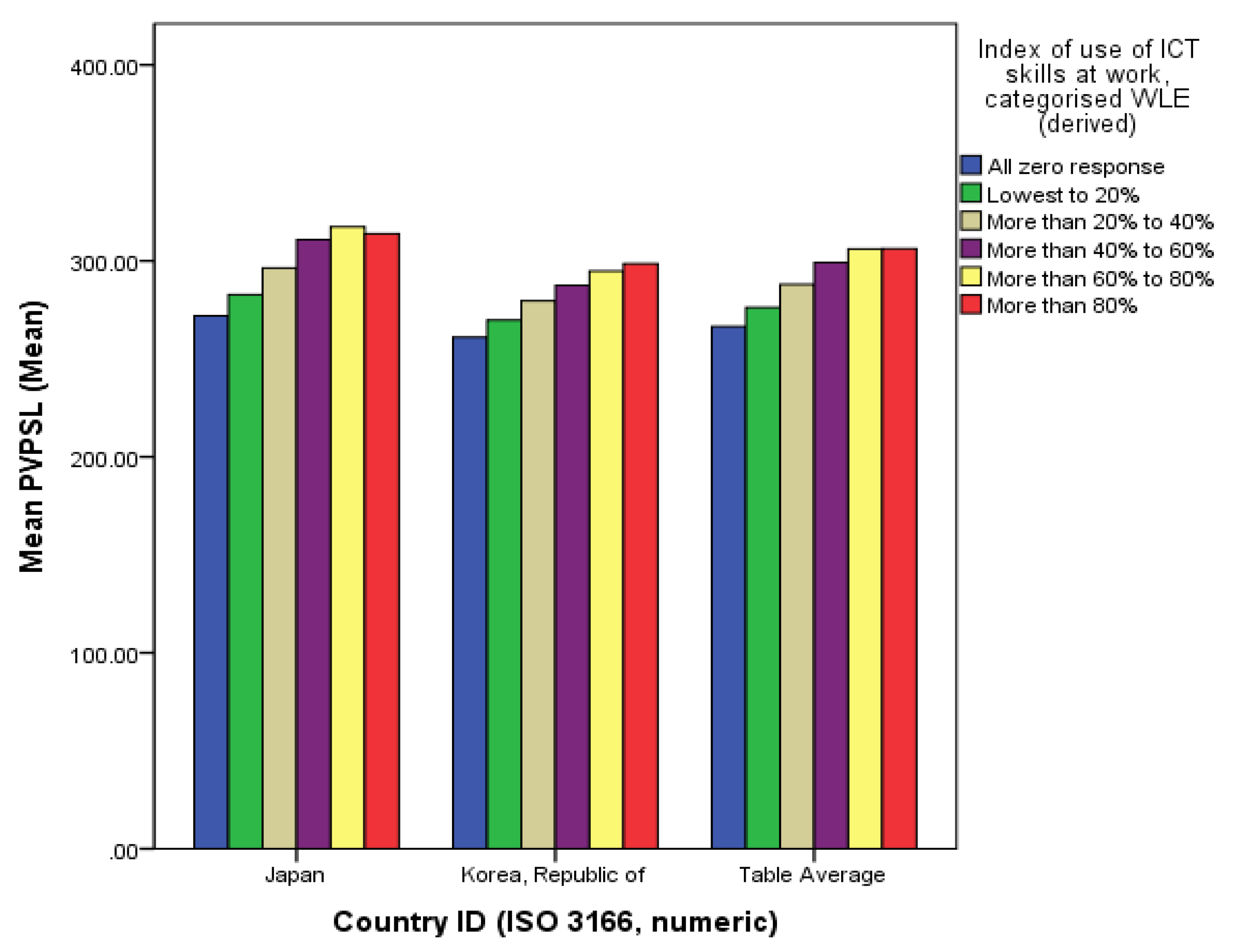
| Proficiency Level | Score | Types of Tasks Completed Successfully at Each Level |
|---|---|---|
| Below level 1 | Below 241 | Tasks are based on well-defined problems involving the use of only one function within a generic interface to meet one explicit criterion without any categorical or inferential reasoning or transforming of information. Few steps are required, and no sub-goal has to be generated. |
| 1 | 241 to less than 291 | Tasks typically require the use of widely available and familiar technology applications, such as e-mail software or a web browser. There is little or no navigation required to access the information or commands required to solve the problem. The problem may be solved regardless of the respondent’s awareness and use of specific tools and functions (e.g., a sort function). The tasks involve few steps and a minimal number of operators. At the cognitive level, the respondent can readily infer the goal from the task statement; problem resolution requires the respondent to apply explicit criteria; and there are few monitoring demands. |
| 2 | 291 to less than 341 | Tasks typically require the use of both generic and more specific technology applications (e.g., a novel online form). Some navigation across pages and applications is required to solve the problem. The use of tools (e.g., a sort function) can facilitate the resolution of the problem. The task may involve multiple steps and operators. The goal of the problem may have to be defined by the respondent, though the criteria to be met are explicit. There are higher monitoring demands. |
| 3 | Equal to or higher than 341 | Tasks typically require the use of both generic and more specific technology applications. Some navigation across pages and applications is required to solve the problem. The use of tools (e.g., a sort function) is required to make progress toward the solution. The task may involve multiple steps and operators. The goal of the problem may have to be defined by the respondent, and the criteria to be met may or may not be explicit. There are typically high monitoring demands. |
| Type | Variable | Values | |
|---|---|---|---|
| Dependent | PSTRE | 0–500 | |
| Independent | Cultural Capital | Number of books | 1 = 10 or less 2 = 11–50 3 = 51–259 4 = 251–1000 5 = 1000+ |
| Father’s education | 1 = ISCED 1, 2, AND 3C short 2 = ISCED 3(excluding 3C short) and 4 | ||
| Education attainment | 1 = lower secondary or less 2 = upper secondary 3 = post-secondary (non-tertiary) 4 = professional degree 5 = bachelor’s degree 6 = master’s/research degree | ||
| Participation in training | Formal AET for job-related reasons | 0 = did not participate 1 = participated | |
| Informal AET for job-related reasons | |||
| Formal AET for non-job-related reasons | |||
| Informal AET for non-job-related reasons | |||
| Skill usage | Use of influencing skills | 1 = up to 20% 2 = 20–40% 3 = 40–60% 4 = 60–80% 5 = more than 80% (categorized WLE) | |
| Solving simple problems | 1 = never 2 = less than once a month 3 = less than once a week but at least once a month 4 = at least once a week but not every day 5 = every day | ||
| Solving complex problems | |||
| Use of ICT skills at work | 1 = lowest to 20% 2 ≥ 20% to 40% 3 ≥ 40% to 60% 4 ≥ 60% to 80% 5 ≥ 80% (categorized WLE) | ||
| Use of ICT skills at home | |||
| Moderating | Age | Respondent’s age | |
| Control | Gender | 1 = male 2 = female | |
| Occupation | 1 = skilled 2 = semi-skilled white collar 3 = semi-skilled blue-collar 4 = elementary | ||
| Tenure | Time spent in the current job | ||
| Working hours | Weekly working hours | ||
| Monthly wage | 1 = Lowest decile 2 = 9th decile 3 = 8th decile 4 = 7th decile 5 = 6th decile 6 = 5th decile 7 = 4th decile 8 = 3rd decile 9 = 2nd decile 10 = Highest decile (Monthly earning including bonuses, in decile) | ||
| Japan n = 1572 | Korea n = 1637 | |||
|---|---|---|---|---|
| Mean | SD | Mean | SD | |
| PSTRE | 303.14 | 1.53 | 287.88 | 1.32 |
| Basic background | ||||
| Age | 41.14 | 9.95 | 37.82 | 8.63 |
| Age squared | 179.11 | 85.73 | 150.48 | 69.92 |
| Working hour | 43.69 | 12.66 | 44.38 | 13.82 |
| Monthly wage | 6.7 | 2.58 | 6.53 | 2.53 |
| Tenure | 12.29 | 10.58 | 6.22 | 7.93 |
| Female (%) | 36 | 0.48 | 39 | 0.49 |
| ISCOSKIL4_D2(%) | 33 | 0.47 | 39 | 0.49 |
| ISCOSKIL4_D3(%) | 13 | 0.34 | 12 | 0.32 |
| ISCOSKIL4_D4(%) | 1 | 0.1 | 3 | 0.17 |
| Cultural capital | ||||
| Books at home | 3.18 | 1.29 | 3.18 | 1.21 |
| Father’s education_D2(%) | 44 | 0.5 | 36 | 0.48 |
| Father’s education_D3(%) | 3 | 0.46 | 18 | 0.39 |
| EDCAT6_D2(%) | 29 | 0.46 | 3 | 0.46 |
| EDCAT6_D3(%) | 2 | 0.13 | 0 | 0 |
| EDCAT6_D4(%) | 2 | 0.4 | 25 | 0.43 |
| EDCAT6_D5(%) | 38 | 0.48 | 37 | 0.48 |
| EDCAT6_D6(%) | 7 | 0.26 | 7 | 0.26 |
| Participation in training | ||||
| FAET12JR_D2(%) | 2 | 0.14 | 6 | 0.24 |
| FAET12NJR_D2(%) | 1 | 0.07 | 2 | 0.13 |
| NFE12JR_D2(%) | 57 | 0.49 | 65 | 0.48 |
| NFE12NJR_D2(%) | 5 | 0.21 | 11 | 0.31 |
| Skill usage | ||||
| Use of ICT skills at home | 2.25 | 1.22 | 2.88 | 1.43 |
| Use of ICT skills at work | 2.7 | 1.46 | 3.21 | 1.56 |
| Use of influencing skills | 2.96 | 1.41 | 3.1 | 1.44 |
| Solving simple problems | 3.78 | 1.15 | 3.69 | 1.25 |
| Solving complex problems | 2.85 | 1.09 | 3 | 1.16 |
| Japan | Korea | ||||||||||
|---|---|---|---|---|---|---|---|---|---|---|---|
| Age | N | % | PSTRE | Gap | Std.Dev | Age | N | % | PSTRE | Gap | Std.Dev |
| 25–34 | 568 | 28.37 | 312.66 | 39.35 | 25–34 | 771 | 37.33 | 295.05 | 34.67 | ||
| 35–44 | 707 | 34.35 | 305.37 | 7.29 | 40.36 | 35–44 | 773 | 38.43 | 280.87 | 14.18 | 34.70 |
| 45–54 | 516 | 24.45 | 285.14 | 20.23 | 42.76 | 45–54 | 403 | 18.93 | 266.61 | 14.26 | 37.62 |
| 55 and above | 290 | 12.83 | 267.09 | 18.05 | 48.27 | 55 and above | 125 | 5.31 | 259.75 | 6.86 | 34.48 |
| Japan | Korea | |||||||
|---|---|---|---|---|---|---|---|---|
| Skill Use at Home | N | % | PSTRE | Std.Dev | N | % | PSTRE | Std.Dev |
| All zero response | 29 | 1.63 | 267.97 | 48.32 | 26 | 1.33 | 257.94 | 35.37 |
| Lowest to 20% | 627 | 33.07 | 284.37 | 44.71 | 518 | 26.19 | 265.01 | 35.20 |
| > 20% to 40% | 611 | 31.96 | 300.90 | 39.97 | 464 | 23.40 | 283.53 | 34.64 |
| > 40% to 60% | 356 | 18.11 | 312.82 | 39.40 | 344 | 17.11 | 290.91 | 35.24 |
| > 60% to 80% | 186 | 9.34 | 314.83 | 40.23 | 316 | 15.67 | 294.18 | 33.77 |
| > 80% | 112 | 5.89 | 322.86 | 43.77 | 331 | 16.3 | 295.81 | 34.77 |
| Japan | Korea | |||||||
|---|---|---|---|---|---|---|---|---|
| Skill Use at Work | N | % | PSTRE | Std.Dev | N | % | PSTRE | Std.Dev |
| All zero response | 86 | 4.64 | 271.94 | 46. 08 | 54 | 3.25 | 260.98 | 46.08 |
| Lowest to 20% | 426 | 22.78 | 282.74 | 42.51 | 280 | 16.44 | 269.77 | 42.51 |
| > 20% to 40% | 380 | 20.54 | 296.31 | 39.74 | 318 | 17.81 | 279.66 | 39.74 |
| > 40% to 60% | 356 | 18.96 | 310.75 | 39.58 | 260 | 14.88 | 287.54 | 39.58 |
| > 60% to 80% | 385 | 21.32 | 317.34 | 38.03 | 302 | 17.27 | 294.72 | 39.03 |
| > 80% | 208 | 11.76 | 313.86 | 42.13 | 517 | 30.35 | 298.56 | 42.13 |
| Japan n = 1572 | Korea n = 1637 | |||||||
|---|---|---|---|---|---|---|---|---|
| Model 1 | Model 2 | Model 3 | Model 4 | |||||
| B | S.E. | B | S.E. | B | S.E. | B | S.E. | |
| Basic background | ||||||||
| Age | 1.58 | 1.06 | 1.29 | 1.25 | −1.4 | 1.01 | −1.25 | 1.24 |
| Age squared | −0.37 *** | 0.12 | −0.36 *** | 0.13 | 0.04 | 0.12 | 0.04 | 0.13 |
| Working hours | −0.06 | 0.11 | −0.06 | 0.11 | 0.11 | 0.07 | 0.1 | 0.07 |
| Monthly wage | 1.57 ** | 0.69 | 1.62 ** | 0.7 | 0.63 | 0.54 | 0.62 | 0.53 |
| Tenure | 0.15 | 0.15 | 0.18 | 0.14 | −0.28 * | 0.15 | −0.32 ** | 0.15 |
| Female | −4.91 * | 2.81 | −4.77 * | 2.77 | −6.32 ** | 2.38 | −6.43 *** | 2.4 |
| ISCOSKIL4_D2 | −1.8 | 2.64 | −1.97 | 2.65 | −4.3 * | 2.21 | −4.25 * | 2.2 |
| ISCOSKIL4_D3 | −3.2 | 4.32 | −3.19 | 4.35 | −8.33 ** | 4.01 | −8.29 ** | 3.94 |
| ISCOSKIL4_D4 | −10.03 | 10.37 | −9.49 | 10.09 | −6.8 | 5.85 | −6.94 | 5.77 |
| Cultural capital | ||||||||
| Books at home | 1.83 | 1.14 | 1.88 | 1.15 | 1.79 ** | 0.84 | 1.87 ** | 0.85 |
| Father’s Education_D2 | −2.72 | 2.89 | −3.19 | 2.92 | 1.73 | 2.17 | 1.64 | 2.17 |
| Father’s Education_D3 | 3.51 | 3.1 | 2.91 | 3.2 | 6.03 ** | 3.04 | 6.02 ** | 3.05 |
| EDCAT6_D2 | 11.61 * | 6.68 | 11.83 * | 6.7 | 9.96 | 8.73 | 9.99 | 8.82 |
| EDCAT6_D3 | 5.23 | 9.98 | 5 | 10.05 | ||||
| EDCAT6_D4 | 15.88 *** | 6.11 | 16.15 *** | 6.1 | 20.26 ** | 8.74 | 20.57 ** | 8.84 |
| EDCAT6_D5 | 23.05 *** | 6.86 | 23.49 *** | 6.88 | 23.59 *** | 8.65 | 24.12 *** | 8.74 |
| EDCAT6_D6 | 29.45 *** | 7.51 | 30.3 *** | 7.64 | 26.88 *** | 9.73 | 27.32 *** | 9.75 |
| Skill usage | ||||||||
| Use of ICT skills at home | 6.09 *** | 0.9 | −3.66 | 3.72 | 1.84 ** | 0.72 | 1.81 | 3.94 |
| Use of ICT skills at work | 4.37 *** | 0.99 | 8.12 ** | 3.31 | 2.31 *** | 0.8 | 2.59 | 3.31 |
| Use of influencing skills | −4.6 *** | 1.09 | −1.31 | 3.48 | −1.61 ** | 0.8 | 0.21 | 3.6 |
| Solving simple problems | 3.11 *** | 1.11 | 4.07 | 4.4 | 1.28 | 0.83 | 1.64 | 4.45 |
| Solving complex problems | 0.78 | 1.43 | −0.37 | 5.16 | 0.68 | 1.06 | 1.69 | 4.95 |
| Participation in training | ||||||||
| FAET12JR_D2 | −4.37 | 6.86 | 13.33 | 28.23 | 4.92 | 5.1 | 2.92 | 16.99 |
| FAET12NJR_D2 | 19.06 | 14.39 | −3.42 | 32.33 | −4.66 | 7.57 | 21.8 | 29.86 |
| NFE12JR_D2 | −1.11 | 2.37 | −10.58 | 10.25 | 0.26 | 2.38 | −8.57 | 10.89 |
| NFE12NJR_D2 | 3.4 | 5.57 | −10.4 | 22.82 | 6.32 * | 3.41 | −17.37 | 16.71 |
| Interaction | ||||||||
| COM * AGE | 0.03 | 0.12 | 0.03 | 0.12 | ||||
| SIM * AGE | −0.02 | 0.1 | −0.01 | 0.11 | ||||
| INFLU * AGE | −0.08 | 0.08 | −0.05 | 0.09 | ||||
| ICTHOME * AGE | 0.23 *** | 0.09 | 0.00 | 0.11 | ||||
| ICTWORK * AGE | −0.09 | 0.08 | −0.01 | 0.09 | ||||
| FAET * AGE | −0.42 | 0.63 | 0.06 | 0.47 | ||||
| FAETNJR * AGE | 0.6 | 0.65 | −0.69 | 0.79 | ||||
| NFEJR * AGE | 0.23 | 0.24 | 0.23 | 0.29 | ||||
| NFENJR * AGE | 0.34 | 0.5 | 0.62 | 0.45 | ||||
| (CONSTANT) | 248.2 *** | 22.5 *** | 258.41 *** | 30.13 | 291.33 *** | 23.27 *** | 286.87 *** | 30.83 |
| R square | 0.32 | 0.33 | 0.28 | 0.29 | ||||
© 2020 by the authors. Licensee MDPI, Basel, Switzerland. This article is an open access article distributed under the terms and conditions of the Creative Commons Attribution (CC BY) license (http://creativecommons.org/licenses/by/4.0/).
Share and Cite
Jyung, C.-Y.; Lee, Y.; Park, S.; Cho, E.; Choi, R. Factors Affecting Employees’ Problem-Solving Skills in Technology-Rich Environments in Japan and Korea. Sustainability 2020, 12, 7079. https://doi.org/10.3390/su12177079
Jyung C-Y, Lee Y, Park S, Cho E, Choi R. Factors Affecting Employees’ Problem-Solving Skills in Technology-Rich Environments in Japan and Korea. Sustainability. 2020; 12(17):7079. https://doi.org/10.3390/su12177079
Chicago/Turabian StyleJyung, Chyul-Young, Yoowoo Lee, Sunyoung Park, Eunhye Cho, and Romi Choi. 2020. "Factors Affecting Employees’ Problem-Solving Skills in Technology-Rich Environments in Japan and Korea" Sustainability 12, no. 17: 7079. https://doi.org/10.3390/su12177079
APA StyleJyung, C.-Y., Lee, Y., Park, S., Cho, E., & Choi, R. (2020). Factors Affecting Employees’ Problem-Solving Skills in Technology-Rich Environments in Japan and Korea. Sustainability, 12(17), 7079. https://doi.org/10.3390/su12177079





